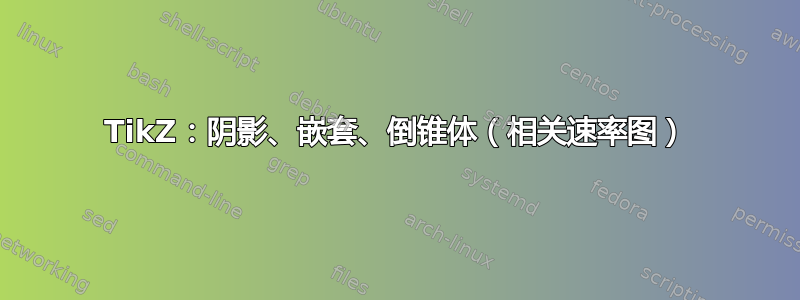
答案1
使用普通的 Ti 可能很难实现阴影效果钾Z/PGFPlots。你最好使用渐近线而是。不过,我已经写了一个 Asymptote 和 Ti钾Z/PGFPlots 解决方案。
渐近线解
请注意,我花了一整夜的时间学习了 Asymptote 的基础知识,才想出了这个解决方案(我以前从未使用过它)。从美学上讲,它可以改进。红色文本只是为了显示使用的坐标(位于代码末尾)。最初,我使用这作为起点,始终应该给予信任:)。
\documentclass[border=1cm]{standalone}
\usepackage{asypictureB}
\begin{document}
\begin{asypicture}{name=ConeDiagram}
unitsize(1cm);
import solids;
settings.render = 0;
currentprojection = orthographic(0, 180, -45, up = -Z); //view
pen thick = linewidth(2pt);
real r = 5; // Radius of larger cone
real h = 10; // Height of larger cone
// The next coordinates represents the larger cone
triple origin = (0, 0, 0);
triple coneCenter = (0, 0, h/2);
triple coneTip = (0, 0, h);
triple largerConeRadius=(r,0,0);
// Creating the two cones
revolution largeCone = cone(origin, r, h, axis = Z);
revolution smallCone = cone(coneCenter, r/2, h/2, axis = Z);
// Drawing the two cones on screen
// Use the following for light options: Headlamp, Viewport, White or nolight.
draw(surface(largeCone), surfacepen = white, light = Viewport);
draw(surface(smallCone), surfacepen = lightgreen, light = Viewport);
// Drawing the border around the smaller cone
skeleton s;
largeCone.transverse(
s, reltime(largeCone.g, abs(coneCenter) / h), currentprojection
);
triple smallConeRadius = relpoint(
largerConeRadius -- coneTip, abs(coneCenter) / h
);
draw(s.transverse.back, dashed + green + linewidth(1pt));
draw(s.transverse.front, green + linewidth(1pt));
// The radius lines (from the center of the cone to the edge)
draw(
L = Label("$5f(t)$", position = Relative(0.5), align = N, black),
origin -- largerConeRadius, white + thick
);
draw(
L = Label("$x$", position=Relative(0.5), align = N, black),
coneCenter -- smallConeRadius, white + thick
);
// Vertical line through the middle of the cone
draw(coneTip -- origin, yellow + thick);
// Drawing bottom-right line in the diagram
draw(coneTip -- (r + 1, 0, h), red + thick);
triple smallConeVerticalLineBottomCoord=(r/2, 0, h);
// Vertical line denoting the smaller cone
triple smallConeVericalLineTop = (
smallConeRadius.x + 0.5, smallConeRadius.y, smallConeRadius.z
);
triple smallConeVericalLineBottom = ((r / 2) + 0.5, 0, h);
draw(
L = Label(
"$y$", align=(0, 0), position = MidPoint,
filltype = Fill(white), black
),
smallConeVericalLineBottom -- smallConeVericalLineTop, blue, Arrows3()
);
// Vertical line denoting the larger cone
triple largeConeVericalLineTop = (
largerConeRadius.x + 0.5, largerConeRadius.y, largerConeRadius.z
);
triple largeConeVericalLineBottom = (r + 0.5, 0, h);
draw(
L = Label(
"$10(ft)$", align=(0, 0), position = MidPoint,
filltype = Fill(white), black
),
largeConeVericalLineBottom -- largeConeVericalLineTop, blue, Arrows3()
);
// The labels of the important coordinates used
dot(Label("Origin", align = Z, red), origin);
dot(Label("$AAA$", align = Z, red), smallConeRadius);
dot(Label("$BBB$", align = Z, red), largerConeRadius);
dot(Label("$CCC$", align = Z, red), coneCenter);
dot(Label("$DDD$", align = Z, red), coneTip);
dot(Label("$EEE$", align = N, red), smallConeVericalLineTop);
dot(Label("$FFF$", align = Z, red), smallConeVericalLineBottom);
dot(Label("$GGG$", align = N, red), largeConeVericalLineTop);
dot(Label("$HHH$", align = Z, red), largeConeVericalLineBottom);
\end{asypicture}
\end{document}
钛钾Z 解决方案
\documentclass[border=1cm]{standalone}
\usepackage{pgfplots}
\pgfplotsset{compat=newest}
\usepgfplotslibrary{colormaps}
\usetikzlibrary{arrows.meta}
\tikzset{%
customTip/.tip={stealth[angle=0:4pt]Bar[sep=1pt,width=10pt]},
}
% Custom colours used
\definecolor{lightBlue}{rgb}{0.03, 0.91, 0.87}
\definecolor{darkBlue}{rgb}{0.0, 0.75, 1.0}
% Formula for the cone is copied from http://pgfplots.sourceforge.net/gallery.html (example 169)
\begin{document}
\begin{tikzpicture}
\begin{axis}[
view={0}{22.5},
hide axis, axis lines=center,
clip=false,
domain=0.0075:1, y domain=0:2*pi,
xmin=-1.25, xmax=1.25,
ymin=-1.25, ymax=1.25,
ymin=-1.25, ymax=1.25,
samples=45 % The more samples, the sharper the diagram which takes longer to render
]
% Larger cone
\addplot3 [surf, shader=interp,
mesh/interior colormap={outerConeColourMap}{
color=(gray) % bottom colour
color=(lightgray)
color=(gray)
color=(darkgray)
color=(gray) % top colour
},
mesh/interior colormap thresh=1
] ({x*cos(deg(y))}, {x*sin(deg(y))}, {x});
% Smaller cone
\addplot3 [surf, shader=interp,
mesh/interior colormap={innerConeColourMap}{
color=(darkBlue) % bottom colour
color=(lightBlue)
color=(darkBlue) % top colour
},
mesh/interior colormap thresh=1
] ({x/2*cos(deg(y))}, {x/2*sin(deg(y))}, {x/2});
% Generating points to refer to later.
\coordinate (origin) at (0, 0, 0);
\coordinate (bottomConeLeft) at (0.05, 0, 0);
\coordinate (middleConeLeft) at (0, 3, 0);
\coordinate (topConeLeft) at (0, 6, 0);
%
\coordinate (bottomConeRight) at (1.25, 0, 0);
\coordinate (middleConeRight) at (0.5, 3, 0);
\coordinate (topConeRight) at (1, 6, 0);
%
% Horizontal line at the bottom of cone
\draw[blue, very thick](bottomConeLeft) -- (bottomConeRight);
% Horizontal line at the middle of cone
\draw[yellow, very thick](middleConeLeft) --
node[black, above, yshift=-2pt]{$x$}(middleConeRight);
% Horizontal line at the top of cone
\draw[green, thick](topConeLeft) -- node[black, above]{$5(ft)$}(topConeRight);
% Vertical line in middle of cone
\draw[red,very thick](origin) -- (0, 6.025, 0);
% Adding the vertical lines with arrow tips
\draw[customTip-customTip, blue, thick]
([xshift=1em]middleConeRight) -- node[black, above, fill=white, pos=0.65]{$y$}
([xshift=1em]middleConeRight|-bottomConeRight);
%
\draw[customTip-customTip, blue, thick]
([xshift=1em]topConeRight) -- node[black, above, fill=white, pos=0.55]{$10(ft)$}
([xshift=1em]topConeRight|-bottomConeRight);
\end{axis}
\end{tikzpicture}
\end{document}





